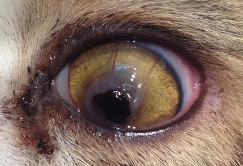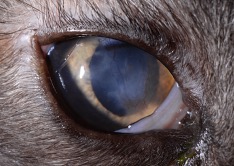A corneal sequestrum in a cat is a focal region of stromal pigmentation and necrosis (dead cells). The occurrence of sequestra is typically unique to cats and is associated with a brachycephalic breed disposition (such as Persians) and often an active feline herpes virus infection.

Feline herpes virus is ubiquitous in the feline population; approximately 90% of cats are believed to be infected with the virus. Infection typically occurs during kitten-hood, after which the virus becomes dormant and settles in peripheral nerves. Clinical recrudescence (flare up) of the viral infection can occur later in life and is typically triggered by a stressful experience. Flare ups of herpes can be managed with the use of antiviral medications. Brachycephalic cats, including Persian cats, appear to be more susceptible to developing sequestra, likely due to a combination of incomplete closure of the eyelids, decreased tear production, or poor tear film quality associated with these breeds. The presence of a corneal sequestrum in a cat hinders the ability of corneal ulcers to heal and represents a source of discomfort and thus must be removed to effectively address the pain and ocular risks associated with chronic corneal ulceration.

The gold standard in treating corneal sequestra is surgical removal known as a keratectomy (corneal surgery to cut out the sequestrum) followed by corneo-conjunctival transposition (a procedure to cover the corneal defect with clear cornea) or conjunctival graft. This procedure requires general anesthesia.
Alternatively, if a sequestrum is fairly superficial, and general anesthesia needs to be avoided, it may be possible to remove the lesion using only a local topical anesthetic in some patients. Even if the sequestrum is present in some deeper layers of the cornea, it is possible that any piece of the sequestrum that remains may slough by itself. This can be an uncomfortable process and sometimes after sloughing a deep or full thickness (perforating) corneal defect results unexpectedly.
Postoperative therapy general includes topical antibiotics and lubrication, systemic pain medications and/or anti-inflammatories, and an E-collar if the patient is rubbing at the eye.